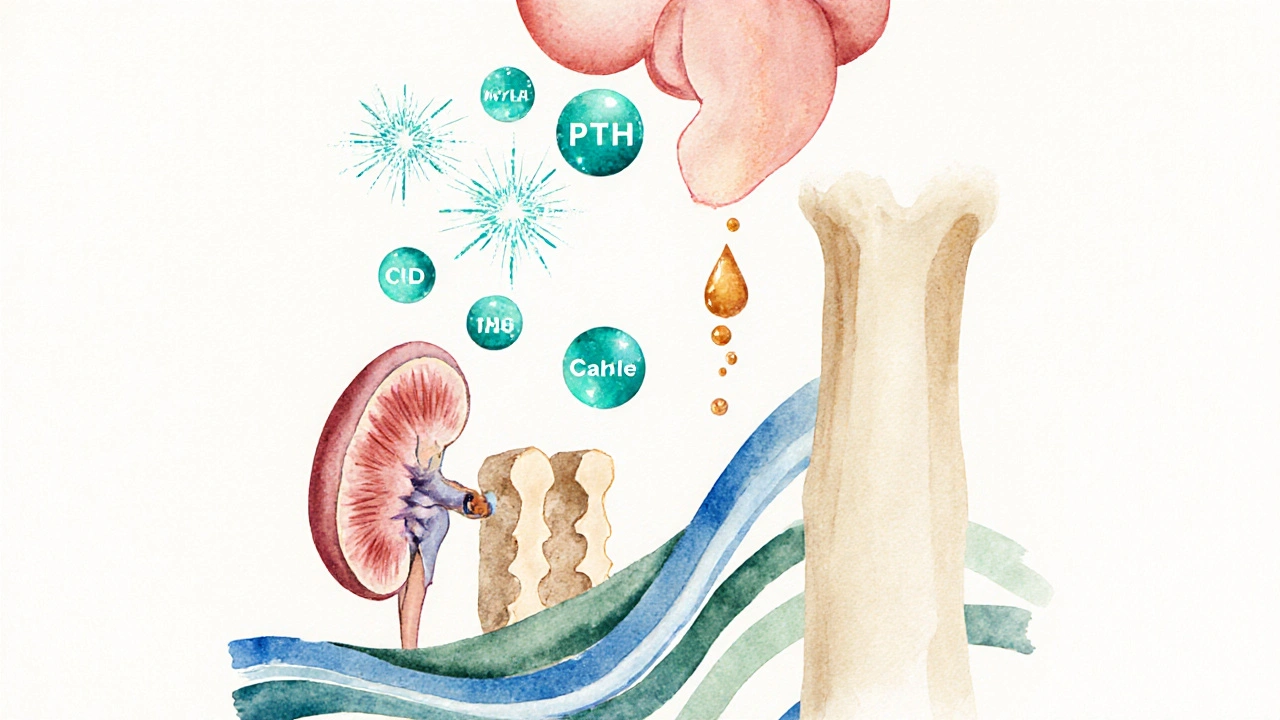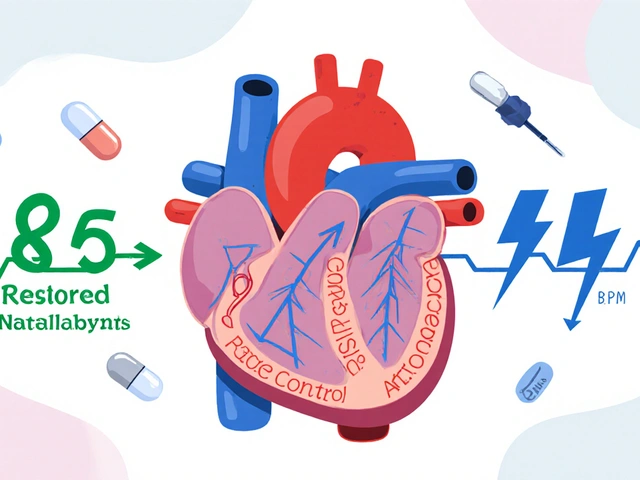Hypocalcemia-Hypomagnesemia Relationship Calculator
Clinical Interpretation Guide
This tool provides a basic assessment of electrolyte relationships. Always consider clinical context and confirmatory lab tests for diagnosis and management.
Hypocalcemia is a condition where serum calcium drops below the normal reference range (usually < 2.1mmol/L) and can cause muscle cramps, tingling, or even cardiac arrhythmias. Hypomagnesemia refers to low blood magnesium levels (typically < 0.7mmol/L), a state that often flies under the radar but has a surprisingly strong effect on calcium balance. When magnesium is low, the body’s ability to regulate calcium through hormones like Parathyroid hormone (PTH) is compromised, creating a cascade that can push calcium even lower. Understanding this two‑way relationship helps clinicians avoid misdiagnosis and treat patients more efficiently.
Key Takeaways
- Low magnesium impairs PTH secretion and action, often causing refractory hypocalcemia.
- Correcting magnesium first resolves many cases of unexplained hypocalcemia.
- Both electrolytes share renal handling pathways; kidney disease amplifies the problem.
- Laboratory evaluation should include calcium, magnesium, PTH, vitamin D, and renal function.
- Treatment involves oral or IV magnesium, followed by calcium and vitamin D as needed.
Basic Physiology of Calcium and Magnesium
Calcium and magnesium are divalent cations that perform distinct yet overlapping roles. Calcium is the primary mineral for bone mineralization, muscle contraction, and blood clotting. Magnesium acts as a co‑factor for more than 300 enzymatic reactions, stabilizes ATP, and modulates ion channels.
Both minerals are filtered at the glomerulus and reabsorbed mainly in the loop of Henle and the distal tubule. The renal tubular reabsorption process for magnesium is magnesium‑dependent; when magnesium is scarce, the kidney conserves it, but the same pathway can affect calcium handling, especially under the influence of PTH.
How Low Magnesium Triggers Low Calcium
The link hinges on three mechanisms:
- PTH Secretion: Magnesium is required for the secretory granules of the parathyroid glands to release PTH. When magnesium falls below ~0.5mmol/L, PTH release drops dramatically, mimicking primary hypoparathyroidism.
- PTH Target‑Organ Sensitivity: Even if PTH is secreted, low magnesium reduces the responsiveness of bone and kidney receptors, blunting calcium mobilization and reabsorption.
- Vitamin D Activation: Magnesium is a co‑factor for 25‑hydroxylase and 1‑α‑hydroxylase, enzymes that convert vitamin D to its active form. Insufficient magnesium therefore limits active vitamin D, decreasing intestinal calcium absorption.
Clinical studies from 2023‑2024 show that up to 40% of patients with refractory hypocalcemia had undiagnosed hypomagnesemia, and magnesium repletion alone corrected calcium in two‑thirds of those cases.
Clinical Presentation: When to Suspect the Pair
Both disorders share overlapping signs, making diagnosis tricky. Typical features include:
- Neuromuscular irritability: tingling, tetany, carpopedal spasm.
- Cardiac: prolonged QT interval, arrhythmias, hypotension.
- Psychiatric: anxiety, irritability, seizures (more common with severe hypomagnesemia).
Because magnesium deficiency often precedes calcium drop, patients may present with muscle cramps that do not improve after calcium supplementation. A clue is persistent hypocalcemia despite adequate calcium and vitamin D therapy.

Diagnostic Work‑up
Comprehensive labs are essential. Order the following in a single panel when you suspect an electrolyte disorder:
- Serum total and ionized calcium.
- Serum magnesium.
- PTH (intact).
- 25‑hydroxy vitamin D and, if low, 1,25‑dihydroxy vitamin D.
- Renal function: serum creatinine, eGFR.
- Phosphate, as hypophosphatemia can coexist and impact calcium.
Interpretation tip: If calcium is low, magnesium is < 0.7mmol/L, and PTH is inappropriately low or normal, think magnesium‑driven hypocalcemia.
Management Strategies
Effective treatment follows a step‑wise approach:
- Magnesium Repletion: Oral magnesium oxide (400‑800mg elemental Mg daily) works for mild cases. For severe symptomatic patients (e.g., arrhythmias), give 1‑2g of magnesium sulfate IV over 30minutes, then a maintenance infusion.
- Calcium Replacement: Once magnesium is on the rise, administer calcium gluconate IV (10mL of 10% solution) for acute symptoms, followed by oral calcium carbonate (500‑1000mg elemental calcium) for maintenance.
- Vitamin D Optimization: Correct deficiency with cholecalciferol 1000‑2000IU daily; if active vitamin D is low, add calcitriol 0.25‑0.5µg daily.
- Address Underlying Causes: Chronic alcoholism, diuretic use, malabsorption, or renal disease require targeted therapy.
Monitoring: Re‑check serum magnesium and calcium every 12‑24hours during acute therapy, then weekly until stable.
Common Pitfalls and How to Avoid Them
- Giving Calcium First: If magnesium isn’t corrected, calcium may drop again, leading to a cycle of re‑infusion.
- Ignoring Renal Status: In CKD, both magnesium and calcium excretion are impaired; dosing must be adjusted to avoid hypermagnesemia or hypercalcemia.
- Over‑reliance on Total Calcium: Ionized calcium reflects the physiologically active fraction; check it when albumin is abnormal.
Quick Reference Checklist
- Check serum Mg, Ca, PTH, vitamin D, renal function.
- If Mg < 0.7mmol/L, start magnesium replacement before calcium.
- Monitor electrolytes every 12-24h during acute phase.
- Address lifestyle factors: alcohol, proton‑pump inhibitor use, high‑dose loop diuretics.
- Re‑evaluate PTH after Mg normalizes; adjust calcium/vit D accordingly.
Related Concepts
The interplay of these electrolytes also touches on other conditions such as osteoporosis, tetany, and cardiac arrhythmias. Understanding the magnesium‑calcium axis can refine treatment plans for patients with chronic kidney disease, bariatric surgery, or long‑term diuretic therapy.
| Feature | Hypocalcemia | Hypomagnesemia |
|---|---|---|
| Typical Serum Level | < 2.1mmol/L | < 0.7mmol/L |
| Primary Hormonal Effect | Reduced PTH activity | Impaired PTH release & target‑organ sensitivity |
| Neuromuscular Signs | Tetany, paresthesia | Muscle cramps, seizures |
| Cardiac Manifestations | Prolonged QT | Arrhythmias, torsades de pointes |
| Response to Calcium Alone | Often resolves | Usually refractory until Mg corrected |

Frequently Asked Questions
Can hypomagnesemia cause low calcium even if I take calcium supplements?
Yes. Magnesium is needed for PTH secretion and vitamin D activation. Without enough magnesium, the body can’t use supplemental calcium effectively, so levels stay low.
What is the fastest way to correct severe hypomagnesemia?
Give 1-2g of magnesium sulfate intravenously over 30minutes, followed by a maintenance infusion (e.g., 0.5g/hour) until serum magnesium rises above 0.7mmol/L.
Should I always check magnesium when I see low calcium?
Absolutely. Magnesium deficiency is a common hidden cause of refractory hypocalcemia, especially in patients on diuretics, alcohol abuse, or with chronic kidney disease.
Is oral magnesium as effective as IV magnesium?
For mild to moderate deficiency, oral magnesium oxide or citrate works well. IV magnesium is reserved for severe symptoms, cardiac arrhythmias, or when the gut cannot absorb.
Can high magnesium levels cause high calcium?
Hypermagnesemia does not directly raise calcium, but it can suppress PTH, potentially worsening low calcium if the patient is already deficient.



 Medications
Medications





Tim Ferguson
October 3, 2025 AT 23:33Yeah, because magnesium is the secret wizard of calcium.
Anastasia Petryankina
October 8, 2025 AT 14:53One must applaud the article's attempt to distill the labyrinthine interplay of calcium and magnesium into a tidy checklist, though the prose drips with the kind of pretentiousness usually reserved for symposium abstracts written by people who think that referencing Parathyroid Hormone makes them sound profound.
Noah Cokelaere
October 13, 2025 AT 06:00Interesting read, though I can’t help but wonder why nobody mentioned the existential crisis that a low‑magnesium patient must undergo when their calcium levels decide to take a vacation.
Ashley Helton
October 17, 2025 AT 21:06Well, if we’re handing out medals for over‑complicating electrolytes, this piece surely deserves a gold star. Still, the practical tips are actually useful, so kudos for not completely losing the plot.
Brian Jones
October 22, 2025 AT 12:13Tim, you’re right; magnesium does feel like the backstage crew that never gets applause. Remember, though, that supplement dosing should be adjusted for renal function-don’t just flood patients with megadoses!!
Carlise Pretorius
October 27, 2025 AT 02:20i think the table is helpful but the mg level typo (magnesuim) confused me a bit lol
Johnson Elijah
October 31, 2025 AT 17:26Hey Carlise, no worries! 🙌 The important part is that you caught the typo-otherwise we might all be dosing the wrong electrolyte. 🌟
Roxanne Lemire
November 5, 2025 AT 08:33While the article is thorough, it could benefit from a clearer distinction between total and ionized calcium, especially in patients with hypoalbuminemia.
Amanda Jennings
November 9, 2025 AT 23:40Exactly, Roxanne! I’ve seen a handful of charts where they forget ionized calcium completely-big oops. Adding a quick note about albumin correction would save a lot of headscratchers.
alex cristobal roque
November 14, 2025 AT 14:46First, let me say that this article does a solid job of laying out the basic physiology of calcium and magnesium, which is essential for anyone working in acute care. Second, the emphasis on magnesium repletion before calcium supplementation aligns with the most recent guideline updates, and that is a point that is too often missed in bedside teaching. Third, I appreciate the clear tabular comparison; visual learners love that. Fourth, the inclusion of PTH and vitamin D measurements rounds out the diagnostic work‑up nicely, giving clinicians a roadmap that avoids blind trial‑and‑error. Fifth, the recommendation to monitor electrolytes every 12‑24 hours during acute therapy is practical and prevents iatrogenic swings. Sixth, it wisely cautions about hypermagnesemia in renal failure, a nuance that can be life‑threatening if ignored. Seventh, the article correctly notes that oral magnesium oxide is adequate for mild deficiencies, but reserves IV magnesium for severe cases, which mirrors real‑world practice. Eighth, the discussion of magnesium as a co‑factor for vitamin D activation is often under‑emphasized elsewhere, so kudos for bringing that up. Ninth, I would have liked to see a brief note on the role of loop diuretics in magnesium loss, as that is a common contributor in ICU patients. Tenth, the piece could benefit from a short algorithm flowchart to guide ordering labs, but the text does a decent job anyway. Eleventh, the mention of “intracellular magnesium” is missing, and while serum levels are the standard, clinicians should remember that tissue stores may lag behind. Twelfth, the article’s tone is appropriately balanced-informative without being condescending. Thirteenth, the occasional typographical error (“magnesuim”) slipped through, but it doesn’t detract from the overall message. Fourteenth, the supportive tone encourages clinicians to check magnesium early, which can reduce unnecessary calcium supplementation. Fifteenth, the final checklist is a practical tool that can be printed and kept at the bedside. In summary, the article is a commendable effort, and with a few minor tweaks it could become a go‑to reference for both residents and seasoned practitioners.
Bridget Dunning
November 19, 2025 AT 05:53One must commend the author for an exhaustive exposition; however, the manuscript would benefit from a more rigorous integration of calcium‑magnesium homeostasis within the broader context of mineral metabolism, particularly regarding the interplay with phosphate and fibroblast growth factor‑23.
Shweta Dandekar
November 23, 2025 AT 21:00While the content is comprehensive, I must insist that future revisions include a disclaimer about the potential legal liability of off‑label magnesium dosing!!! Such omissions are simply unacceptable in today's clinical literature!!!
Gary Smith
November 28, 2025 AT 12:06Let’s be honest, this whole magnesium hype is just a way for pharmaceutical companies to sell more supplements, and we should be skeptical of every “new” recommendation.
Dominic Dale
December 3, 2025 AT 03:13Gary, you’re buying into the mainstream narrative, but have you considered that the labs we rely on are part of a larger data‑harvesting scheme controlled by shadowy cabals? The “magnesium‑calcium” story is just a distraction.
christopher werner
December 7, 2025 AT 18:20I appreciate the thoroughness here, but let’s keep the discussion focused on evidence‑based practice without veering into speculation.
Matthew Holmes
December 12, 2025 AT 09:26Dominic, your conspiracy angle is as dramatic as a theater performance, yet the real drama unfolds when a patient’s ECG goes into torsades because we ignored magnesium.
Remember, the stakes are tangible, not imagined.
Patrick Price
December 17, 2025 AT 00:33i think the article is good but the code snippets were missing
Travis Evans
December 20, 2025 AT 20:46Patrick, you’re right-adding a splash of color to the treatment plan can really brighten a clinician’s day. Just don’t forget to keep the dosage accurate, or you’ll end up painting a mess instead!